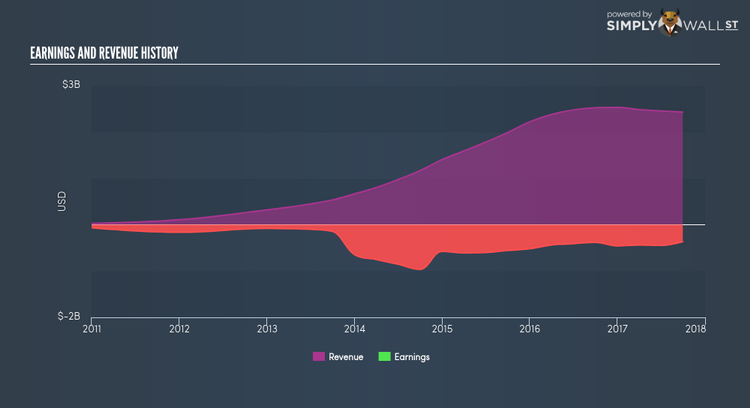Twitter Inc (NYSE:TWTR)’s Earnings Grew 7.8%, Is It Enough?

When Twitter Inc (NYSE:TWTR) released its most recent earnings update (30 September 2017), I wanted to understand how these figures stacked up against its past performance. The two benchmarks I used were Twitter’s average earnings over the past couple of years, and its industry performance. These are useful yardsticks to help me gauge whether or not TWTR actually performed well. Below is a quick commentary on how I see TWTR has performed. Check out our latest analysis for Twitter
Commentary On TWTR’s Past Performance
For the most up-to-date info, I use data from the most recent 12 months, which either annualizes the most recent 6-month earnings update, or in some cases, the most recent annual report is already the latest available financial data. This allows me to examine various companies on a similar basis, using the most relevant data points. For Twitter, the latest earnings -$366.2M, which, against last year’s level, has become less negative. Given that these figures may be relatively nearsighted, I’ve created an annualized five-year value for Twitter’s earnings, which stands at -$438.7M. This suggests that, despite the fact that net income is negative, it has become less negative over the years.
We can further assess Twitter’s loss by looking at what’s going on in the industry along with within the company. Firstly, I want to quickly look into the line items. Revenue growth over the last few years has risen by 33.79%, signalling that Twitter is in a high-growth phase with expenses racing ahead elevated top-line growth rates. Looking at growth from a sector-level, the US internet industry has been growing, albeit, at a subdued single-digit rate of 7.42% in the past twelve months, and a substantial 15.52% over the previous five years. This means whatever uplift the industry is benefiting from, Twitter has not been able to reap as much as its industry peers.
What does this mean?
While past data is useful, it doesn’t tell the whole story. With companies that are currently loss-making, it is always hard to forecast what will happen in the future and when. The most useful step is to examine company-specific issues Twitter may be facing and whether management guidance has steadily been met in the past. I recommend you continue to research Twitter to get a better picture of the stock by looking at:
1. Future Outlook: What are well-informed industry analysts predicting for TWTR’s future growth? Take a look at our free research report of analyst consensus for TWTR’s outlook.
2. Financial Health: Is TWTR’s operations financially sustainable? Balance sheets can be hard to analyze, which is why we’ve done it for you. Check out our financial health checks here.
3. Other High-Performing Stocks: Are there other stocks that provide better prospects with proven track records? Explore our free list of these great stocks here.
NB: Figures in this article are calculated using data from the last twelve months, which refer to the 12-month period ending on the last date of the month the financial statement is dated. This may not be consistent with full year annual report figures.
To help readers see pass the short term volatility of the financial market, we aim to bring you a long-term focused research analysis purely driven by fundamental data. Note that our analysis does not factor in the latest price sensitive company announcements.
The author is an independent contributor and at the time of publication had no position in the stocks mentioned.

